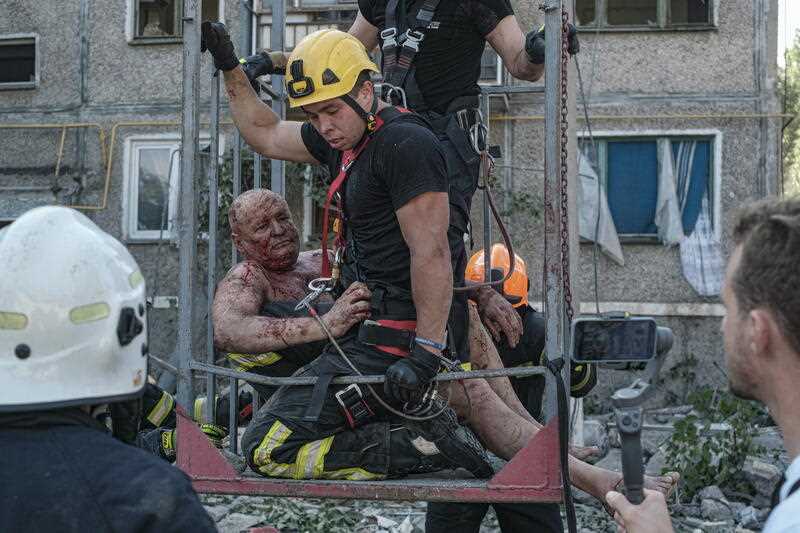NATO has branded Russia the biggest “direct threat” to Western security after its invasion of Ukraine and agreed plans to modernise Kyiv’s beleaguered armed forces, saying it stood fully behind Ukrainians’ “heroic defence of their country”.
At a summit dominated by the invasion and the geopolitical upheaval it has caused, NATO also invited Sweden and Finland to join and pledged a sevenfold increase from 2023 in combat forces on high alert along its eastern flank against any future Russian attack.
In reaction, President Vladimir Putin said Russia would respond in kind if NATO set up infrastructure in Finland and Sweden after they joined the US-led military alliance.
Putin was quoted by Russian news agencies as saying he could not rule out that tensions would emerge in Moscow’s relations with Helsinki and Stockholm over their joining NATO.
US President Joe Biden announced more land, sea and air force deployments across Europe from Spain in the west to Romania and Poland bordering Ukraine.
These included a permanent army headquarters with accompanying battalion in Poland – the first full-time US deployment on NATO’s eastern fringes.
“President Putin’s war against Ukraine has shattered peace in Europe and has created the biggest security crisis in Europe since the Second World War,” NATO Secretary-General Jens Stoltenberg told a news conference on Wednesday.
“NATO has responded with strength and unity.”
As the 30 national NATO leaders were meeting in Madrid, Russian forces intensified attacks in Ukraine, including missile strikes and shelling on the southern Mykolaiv region close to front lines and the Black Sea.
The mayor of Mykolaiv city said eight Russian missiles had struck the city, and one had killed at least five people in a residential building there, while Moscow said its forces had hit what it called a training base for foreign mercenaries in the region.
The governor of eastern Luhansk province reported “fighting everywhere” in a battle around the hilltop city of Lysychansk, which Russian forces are trying to encircle as they gradually advance in a campaign to conquer Ukraine’s industrialised eastern Donbas region on behalf of separatist proxies. Donbas comprises Donetsk and Luhansk provinces.
President Volodymyr Zelenskiy once again told NATO that Ukrainian forces needed more weapons and money, and faster, to erode Russia’s huge edge in artillery and missile firepower, and said Moscow’s ambitions did not stop at Ukraine.
Russia says its invasion that began on February 24 is a “special military operation” to rid Ukraine of dangerous nationalists. Ukraine and the West accuse Russia of an unprovoked, imperial-style land grab.
In a nod to the deterioration in relations with Russia since the invasion, a NATO communique called Russia the “most significant and direct threat to the allies’ security”, having previously classified it as a “strategic partner”.
NATO issued a new Strategic Concept document, its first since 2010, that says a “strong independent Ukraine is vital for the stability of the Euro-Atlantic area”.
To that end, NATO agreed a long-term financial and military aid package to modernise Ukraine’s military.
“We stand in full solidarity with the government and the people of Ukraine in the heroic defence of their country,” the communique said.
Stoltenberg said NATO had agreed to put 300,000 troops on high readiness from 2023, up from 40,000, to protect an area stretching from the Baltic to the Black seas.
Zelenskiy, in a video link-up with the summit, said Ukraine needed $US5 billion ($A7.3 billion) a month for its defence and protection.
“This is not a war being waged by Russia against only Ukraine. This is a war for the right to dictate conditions in Europe, for what the future world order will be like,” he said.
NATO’s invitation to Sweden and Finland to join the alliance marks one of the most momentous shifts in European security in decades as Helsinki and Stockholm drop a tradition of neutrality in response to Russia’s invasion.
By Sabine Siebold, Robin Emmott and Pavel Polityuk in Madrid
Get the latest Canberra news, sport, entertainment, lifestyle, competitions and more delivered straight to your inbox with the Canberra Daily Daily Newsletter. Sign up here.



